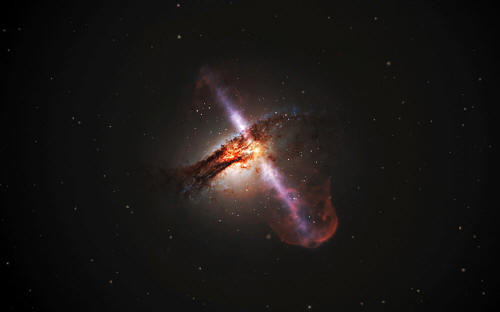|
by Charles Q. Choi
from a supermassive black hole would look.
A newfound giant black hole nearly as massive as 7 billion suns is dozens of times larger than astronomers expected given its host galaxy's size, researchers say.
This finding may call most current models of galaxy formation into question, scientists added.
Astronomers investigated a supermassive black hole known as CID-947 using the,
This black hole, one of the largest ever seen, formed in the early universe about 11.7 billion years ago - 2 billion years after the Big Bang. The very fast motion of gas near the black hole suggests that it has a very high mass - the equivalent of about 7 billion suns.
The discovery was unexpected.
However, it was the mass of the galaxy surrounding this black hole that most surprised the research team.
Most galaxies, including the Milky Way, possess at their hearts a supermassive black hole with a mass ranging from millions to billions of times the mass of the sun.
The supermassive black holes seen up to now usually make up only 0.2 to 0.5 percent of the mass of their galaxies - far less than CID-947 does.
The result was so surprising that the astronomers had outside experts verify their results independently.
Current models of galaxy formation suggest that galaxies and their supermassive black holes evolve in sync, growing at the same rate.
However, CID-947 defies this rule, precociously growing much faster than researchers would have predicted.
In addition, the scientists found that, although the black hole had reached the end of its growth, stars were still forming in its galaxy.
Prior research suggested that radiation and flowing gas from around the black hole would stifle the birth of stars.
This finding supports previous research suggesting that black holes may have grown incredibly rapidly in the newborn universe, Benny Trakhtenbrot said.
For instance, the early universe was much smaller, and thus denser, on average than it is today, which could have helped black holes back then gorge on,
Trakhtenbrot and his colleagues now want to analyze more similarly ancient supermassive black holes to learn more about their interplay with their galaxies.
The results (An Over-Massive Black Hole in a Typical Star-Forming Galaxy, 2 Billion Years After the Big-Bang) appear in the July 10 issue of the journal Science.
|


